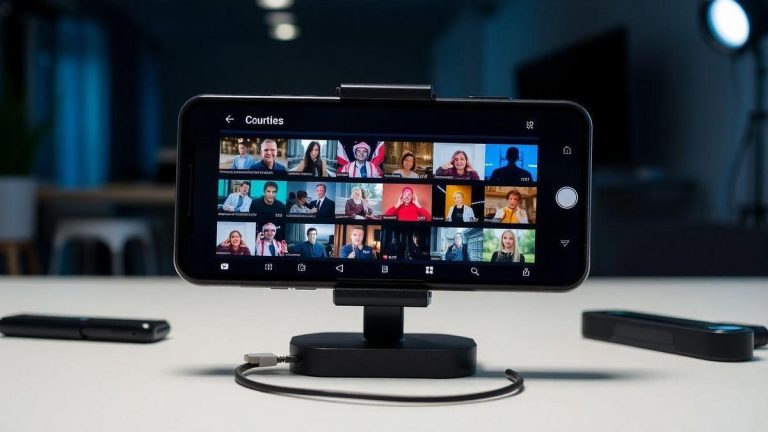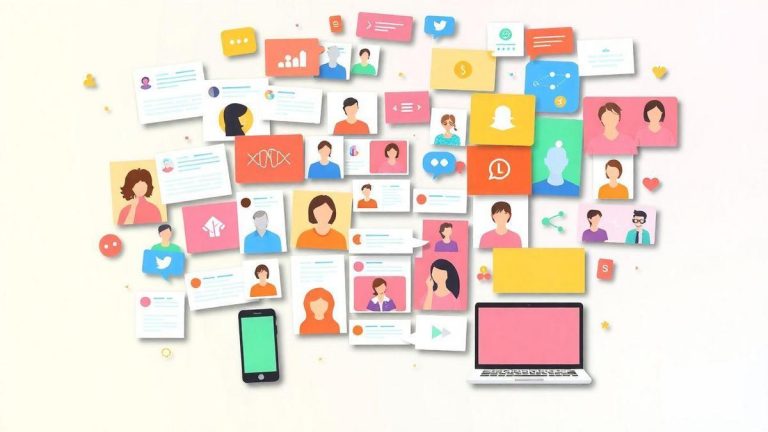Augmented and Virtual Reality in Marketing: How Companies Are Innovating
Augmented and Virtual Reality in Marketing: How Companies Are Innovating is the topic I'll explore in this article. Get ready for a fun journey through the magical world of technology that makes shopping feel more like a video game than a boring chore! I'll show you how brands are brilliantly using it. augmented reality and virtual reality to engage and surprise consumers by creating exciting experiences! Come on, what are you waiting for?
The Augmented Reality Revolution in Marketing
What is Augmented Reality and How Does it Work?
Ah, the Augmented RealityIt's like putting on magic glasses and seeing the world in a completely different way. It blends what we see in real life with digital elements. You know when you point your phone at a spot and a cat appears dancing on the screen? That's augmented reality in action! It works through apps that use your device's camera to add images, sounds, and other data to your view of the world. It's like having a digital assistant that enhances reality with extra information.
Examples of the Use of Augmented Reality in Advertising Campaigns
Let's talk about how companies are leveraging this technology. Here are some great examples:
| Campaign | Description |
|---|---|
| IKEA Place | See how the furniture would look in your home before purchasing. |
| Snapchat Filters | Filters that put dog ears and other effects on your face. |
| Pepsi Max | A campaign that made a bus appear to be falling into a hole in the street. |
These campaigns are so cool they even make me want to buy things I don't need! Augmented reality not only grabs attention, but also makes brands stand out in a sea of boring ads.
How Augmented Reality Improves Customer Experience
When it comes to customer experienceAugmented reality is like a superhero. It makes everything more fun and interactive. Imagine walking into a store and, with a tap on your phone, seeing how a dress would look on you without trying anything on. It's like having a portable fitting room!
Augmented reality helps to educate customers. Some brands use this technology to demonstrate how to use a product or explain its features in a fun way. This means customers feel more confident about their purchases. And, let's be honest, who doesn't love shopping while having fun and learning at the same time?
Virtual Reality: A New World for Marketing
What is Virtual Reality and Why is it Important?
Ah, the virtual reality! It's like a digital amusement park where I can play with everything except the line. It's a technology that creates a simulated environment where you can interact as if you were actually there. And why is this important? Imagine you're selling a car. Instead of looking at pictures, you can "get in" the car and take it for a spin! That's it! much more cool and engaging. And let's face it, who wouldn't want to take a ride in a new car without leaving the couch?
Brands Using Virtual Reality to Engage Users
Now, let's talk about some brands that are riding this virtual reality wave:
| Mark | What do you do with VR? |
|---|---|
| IKEA | Allows you to “place” furniture in your home. |
| Nike | Offers VR racing experiences. |
| Audi | Take virtual test drives of your cars. |
These brands are using virtual reality to connect with consumers in a way that makes you feel like you're actually there. It's like being in the store, but without the pressure of the salesperson.
The Impact of Virtual Reality on Immersive Branding
Virtual reality is not just a fad, it is a way of branding that makes you feel part of the brand. It's like being in a movie, but you're the protagonist! When brands use VR, they create memorable experiences, making us remember them when we're ready to buy.
For example, a clothing brand might use VR to showcase how its pieces look in different environments. This way, you don't just see the clothes, but feel like you're actually walking in them. This is truly powerful!
Innovation in Marketing: The Role of Interactive Technology
How Interactive Technology Transforms Advertising Campaigns
Ah, the interactive technology! When it comes to advertising campaigns, this technology engages people in a way that a traditional poster never could. Just imagine: you're browsing the internet and suddenly an ad appears, seemingly calling you by name and offering you a special discount. It's as if the product has a voice and is inviting you to a conversation!
These campaigns become true experiences. I recently participated in a campaign that used augmented realityI'd point my phone at a product and, boom! It would come to life on the screen, showing how to use it and even giving style tips. It was so cool that I almost bought a shirt I didn't need, just for the experience.
Digital Marketing Tools that Use Augmented Reality
Let's talk about some tools that are changing the game in digital marketing:
| Tool | Description |
|---|---|
| Snapchat | Uses augmented reality filters that make you look like a cat. |
| IKEA Place | Allows you to visualize how furniture would look in your home before purchasing. |
| Google Lens | Helps identify products and provides instant information. |
These tools help businesses connect with consumers in a more fun and engagingAnd who doesn't like a little fun, right?
The Importance of Innovation for Business Success
If there's one thing I've learned in my life as a programming student and in the world of digital media, it's that innovation is the key to success. Without it, companies remain stuck in the past.
Companies that embrace new technologies like augmented and virtual reality stand out and create stronger bonds with their customers. It's as if they're saying, "Hey, we're here for you and want you to have fun while you shop!" And that makes all the difference.
User Engagement: The Magic of Augmented Reality
How Augmented Reality Increases User Engagement
Ah, the Augmented Reality! That technology that makes you feel like you're living in a science fiction movie. When I talk about engagement, I'm referring to the power of augmented reality to capture users' attention and keep them glued to the screen.
For example, imagine you're browsing a shopping app and suddenly you see how that sofa would look in your living room. That increases engagement Because people love to visualize products in their own spaces before purchasing. It's a super interactive experience!
Augmented Reality Engagement Case Studies
A famous example is IKEA, which launched an app where you can see how its furniture would look in your home. You can rotate, move, and even "sit" on the virtual sofa. The result? It increased sales and got people talking about the brand.
Another example is Snapchat, which used augmented reality filters. These filters keep users engaged and sharing, creating a viral effect.
What Does the Data Say About Marketing Engagement?
Research shows that campaigns that use augmented reality have an engagement rate of up to 70% larger than those who don't. It's like you're playing a video game and you find a cheat code that gives you infinite lives.
| Campaign Type | Engagement Rate (%) |
|---|---|
| No Augmented Reality | 20% |
| With Augmented Reality | 70% |
This data shows that the augmented reality is a powerful tool for capturing the public's attention. And who doesn't want more attention, right?
Data Analysis in Marketing: The Future of Augmented Reality
How to Collect and Analyze Campaign Data with Augmented Reality
When I started working with augmented reality (AR), I thought I'd just put on glasses and watch dancing dinosaurs. But data collection is just as important as choosing the right dinosaur! To collect data from AR campaigns, you can use tools like Google Analytics, which help you understand how many people interact with your content.
Here are some tips I've learned:
- Define your goals: What do you want to know? How many people used AR? How long did they spend interacting?
- Use QR Codes: They are like digital passports that take users into the AR experience and can be tracked.
- User Feedback: Ask! A simple survey can reveal whether people found the experience fun.
What Data Can Reveal About Customer Behavior
Data is like a treasure map, showing where customers are and what they really want. When I analyze data from AR campaigns, I notice a few interesting things:
| Behavior | What this could mean |
|---|---|
| High interaction | Customers love the experience! |
| Low rate of return | Something is not working. |
| Positive feedback | People are having fun! |
This information helps me understand what's working and what needs tweaking. For example, if I see people skipping the interaction part, I might need to make the experience more enjoyable. engaging.
Using Data to Improve Augmented Reality in Marketing
Now that I've collected and analyzed the data, it's time to take action! I like to think of data as a trainer that tells me where to improve. If I notice that many users have abandoned the experience, I can make changes.
Here are some strategies I use:
- Enhance the experience: If the data shows that people are losing interest, I can add more fun elements.
- Personalization: Use data to adapt the experience to the user's taste.
- A/B Testing: Test different versions of the campaign to see which one works best.
Immersive Branding: Creating Connections with Virtual Reality
What Is Immersive Branding and How Does It Work?
Ah, the immersive branding! It's a way for brands to connect with people through virtual realityImagine putting on a VR headset and suddenly you're inside a clothing store, able to try everything on without leaving your couch. That's immersive branding!
It works like this: companies create interactive experiences that make you feel part of the brand. The goal? To make you feel special, as if the brand were your best friend.
Examples of Immersive Branding Using Virtual Reality
Here are some brands that are killing it in the world of immersive branding:
| Mark | Immersive Experience | What I Learned |
|---|---|---|
| IKEA | Virtual store tour and furniture assembly | You can see how the furniture looks in your home before you buy! |
| Nike | VR Racing Experience | You race on a virtual track and compete with friends! |
| Coca-cola | Augmented reality game with bottles | You can collect virtual bottles and win prizes! |
These experiences help brands stand out. More and more companies are investing in augmented and virtual reality in marketing to innovate and win customers.
How Immersive Branding Can Increase Sales
When you create an immersive experience, people become more engaged. They feel part of the brand, and guess what? This makes them want to buy more!
Here are some ways I've seen immersive branding help sales:
- Engagement: People spend more time interacting with the brand.
- Memorability: Cool experiences stick in people's minds.
- Recommendations: If you love the experience, you will tell your friends.
When brands can create an emotional connection, sales tend to increase. And who doesn't want to see their sales skyrocket?







